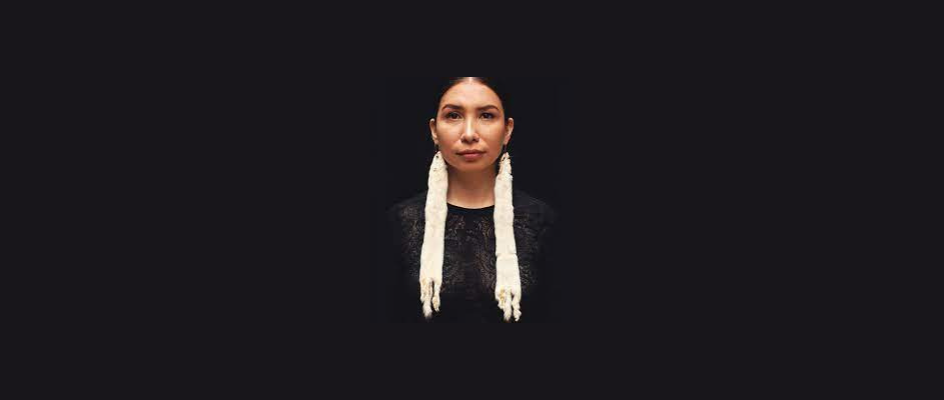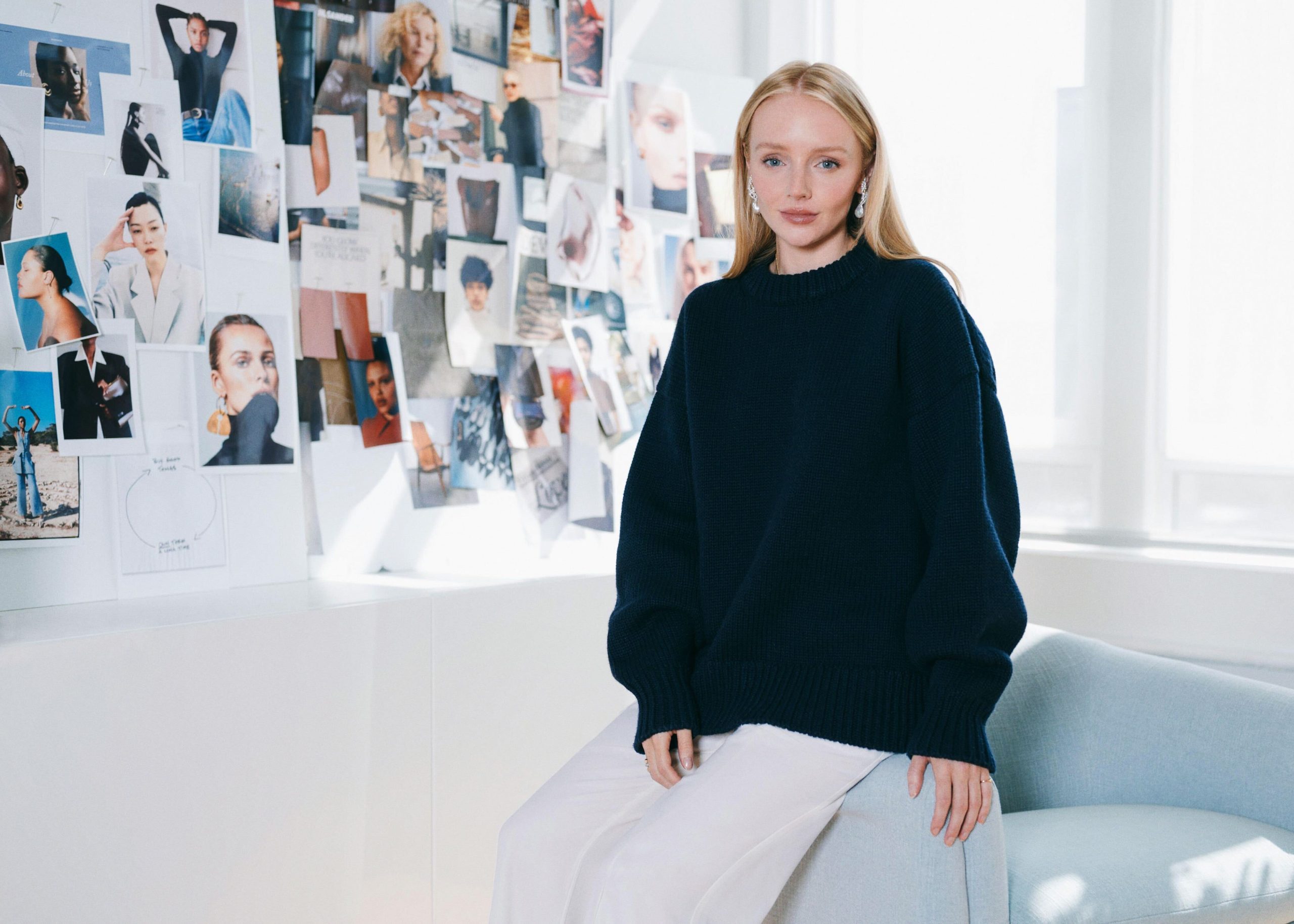Sustainability, upcycling, the circular economy—these are terms that have all become in vogue as the fashion industry (and many others) have attempted to apply a more thoughtful approach to production and consumption. But long before they were assigned their buzzy, marketing-friendly monikers, these values were (and continue to be) stalwarts of Indigenous culture, centred around community, empathy, and respect for the environment around us. Sage Paul wants the world to wake up and pay attention. More specifically, through her platform Indigenous Fashion Arts, the award-winning cultural leader is espousing these very values by raising the profile of Indigenous artists and entrepreneurs with the goal of building economies that celebrate culture.
For our Winter 2022 cover story, the Toronto-based Denesuline designer and member of English River First Nation discusses building her organization, reclaiming traditions, and what excites her most about Indigenous talent today.


You are the co-founder, executive and artistic director of Indigenous Fashion Arts. What is your elevator pitch?
Sage Paul: Indigenous Fashion Arts (IFA) is a non-profit arts organization that supports, fosters, and celebrates Indigenous makers, designers, and artists who work in fashion, craft, and textiles. We do that through the festival, advocacy, incubator, and creation programs.
As the co-founder, why did you feel like this was a platform that was needed?
Sage Paul: I’m a designer and went to school for fashion. I grew up creating fashion and craft, specifically in my own community in Toronto. I worked with a group of women to create a collective for making culturally-relevant work. I just wanted to be seen. Every once in a while, Toronto Fashion Week would have an Indigenous spotlight, but there was never anything consistent that gave access to Indigenous people into the industry. Nor was there anything that aligned with our cultural values. Something like [IFA] is important because it is Indigenous-led. We get to insert our values into the way it’s run and ensure that the people we partner with align accordingly.
When we started, it was very evident that we were hitting an area of need. It wasn’t just me who wanted to see my work represented or have access to resources. Most Indigenous people I know have a family member who makes fashion, craft, or textiles as a big part of their lives. I just got back from Mexico and it’s very similar. This is not unique to Canadian Indigenous people, it’s a global thing.
I think it’s really important that our Indigenous communities are able to be part of the larger economy and culture of Canada, and also creating economic opportunities within our own communities because that is something that just isn’t there in a major way.
Your note about fashion week speaks to a larger dialogue around BIPOC talent and the difference between having the agency to make decisions that align with one’s own values and goals versus being invited into someone else’s vision of that.
Sage Paul: Exactly. It’s a lot of work to be invited into a space and have to reassess how things are done and how people are going to respond. In creating our own platforms, we’ve already built the foundation. We’re just formalizing it and bringing people together. We’re not creating something new, this is something that already exists.
What kind of role did fashion and style have for you growing up?
Sage Paul: It has always been a part of my life. My mom taught me how to sew. She enjoyed fashion and my parents would take us into workshops in our community. It was just a really big part of my growing up and has always been there. It feels really good to be able to continue that work today in a very impactful way.
Where do you see the overlap or differences between the mainstream and Indigenous design and culture?
Sage Paul: I have really been thinking about this lately. The mainstream fashion industry is based on capitalism. It’s said to have started in the 1400s with the aristocrats and is really based on capitalism and style, what’s popular, and what will sell. Whereas Indigenous fashion, of course it has aesthetic beauty, but there are traditions, ceremonial aspects, and stories that are passed down. These stories have been used to warn people about what’s going on, what has happened in the past, and also to identify each other from different nations. There is quite a lot of depth in Indigenous-made fashion, which I think is the big difference.
[We’re] not creating something because it’s going to sell or be popular again in three, five, or ten years. The practices that we are continuing in our communities have been around for hundreds of years, and they’re still here, which I think is quite amazing. Within the last 10 or 15 years, I have seen a huge resurgence and reclamation of Indigenous practices, styles, and ways of knowing and doing that we were forbidden from carrying on because of colonialism, residential schools, and laws that outlawed the practice or display of Indigenous culture.


[Photo: Justin Aranha]
With the emphasis on sustainability and upcycling that we’re seeing, do you think the fashion industry is starting to embrace what have been traditional tenets of Indigenous culture?
Sage Paul: I think the industry is still having a hard time figuring that out. Yes, sustainability is a huge thing in the fashion industry and it’s very apparent that we need to act now to reduce our carbon footprint. But there are six-foot-tall walls of used clothing in places like Guatemala and Ghana that are their own economies. It’s a double-edged sword that I’m seeing. When it comes to Indigenous values, I’m interested in the historical trade roots that happened and how we can restore them because they focused on communal trade. You didn’t waste things and it wasn’t about who had the most capital. If you had an abundance of a certain resource, you would share that with other communities.
How does Indigenous Fashion Arts challenge preconceived notions of what Indigenous design is and can be?
Sage Paul: People are pretty open now. When I started in fashion, I felt constrained to create things that were stereotypically Indigenous, which is kind of a pan-Indian perspective. It was the headdresses and certain kinds of garments. I think things have changed but that goes back to the fact that there’s a lot of people who are more empowered to display their cultures and what those mean. A lot of younger people, myself included, are going to our elders to ask about their culture. There’s an assertion of Indigenous culture that I’m seeing that I hope will continue to grow so we can see it more vibrantly.
On your website, you have the words ‘anti-fashion’ displayed front and center on your homepage. What is the message you’re communicating here?
Sage Paul: Anti-fashion is a fashion movement that looks at subcultures of fashion that have been left out of the mainstream. I think it’s really important to have as part of the fashion scene, whether that’s a subculture like punk or even minority cultures. I think there is a lot more to hold onto when we see fashion through an anti-fashion lens as opposed to what’s popular.
Your homepage also proclaims ‘authentic appropriations’ under your name. Can you elaborate on what you mean by this?
Sage Paul: It’s about having integrity within our ideas. There’s a lot of appropriation that happens in our community and sometimes it isn’t a bad thing because it celebrates a culture. But the thing is, our communities are still marginalized. There are serious issues—no clean drinking water, poverty, and more. When I see major brands making a lot of money off of our culture, it just doesn’t balance out for me. When I think of authentic appropriation, I really want people to think about where things are coming from. What are you putting on your body? How are you making your decisions? I think that’s really important to consider, especially if you are purchasing something from a community that simply does not have all of its needs met.
How do you balance both the joy and trauma that your community experiences?
Sage Paul: [The duality] will always be there until everyone’s needs are met and our wellbeing is good. At our festival, people want to hear about whether it’s okay to wear a certain something. But these are topics that our community is tired of having. We’re not here to service white communities that feel guilty about wearing our stuff. Come and learn about it. And maybe if they do, they will feel more empowered and safe to wear it. We do panel discussions around the importance of hide tanning or around values-based entrepreneurship so our designers can be empowered and feel good. I don’t want all the mental labour to go to the designers that we are supporting. They’re already making these beautiful works, which take a huge amount of time, knowledge, and research. The last thing they want to do is try and explain appropriation to someone. The IFA is really important in that we act as a facilitator and make sure that it comes from an Indigenous perspective.
Speaking of, the IFA Trade Program is launching with WHITE Milano for a three-year project starting in 2023. What will that entail?
Sage Paul: We are so lucky. We’re going to WHITE Milano and our goal is to create an open market for Indigenous designers. If they enter a global market, like Milan, which is one of the top fashion places in the world, there is a lot of work to be done. And there is a lot that can be miscommunicated, not only because of a language barrier, but also if there is a history of colonialism. Some people don’t even know that Indigenous people exist, so as part of the program, we work with designers to prepare to enter that market and so that there is no misunderstanding or miscommunication about who we are and where we come from. We just want to make sure that there is space for Indigenous designers to prosper within the larger fashion industry.
What excites you most about the talent pool of Indigenous artists today?
Sage Paul: What excites me the most is just the way that everyone is doing it. There is such a love and generosity when communities come together. And I say communities because there are so many different nations of Indigenous people with distinct practices and ways of doing things. A lot of designers today are learning from their aunties or grandmas. There is a really strong presence of family, which I think continues that idea of communal trade. I think western mainstream fashion is becoming aware of this. People want to experience culture. It’s not just about wearing the hottest thing, it’s about culture and community, whether it’s a nation or ethnicity of people.
What is your mission at the end of the day?
Sage Paul: I just want our families to be okay and have our needs met. I believe that fashion is a very accessible entry point for that to happen. Plus, it’s fun and beautiful. I have so many ideas and dreams but ultimately, if our community’s needs are met, then the possibilities are endless and the world will be such an interesting place.













